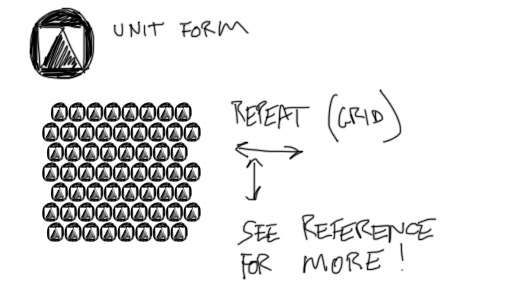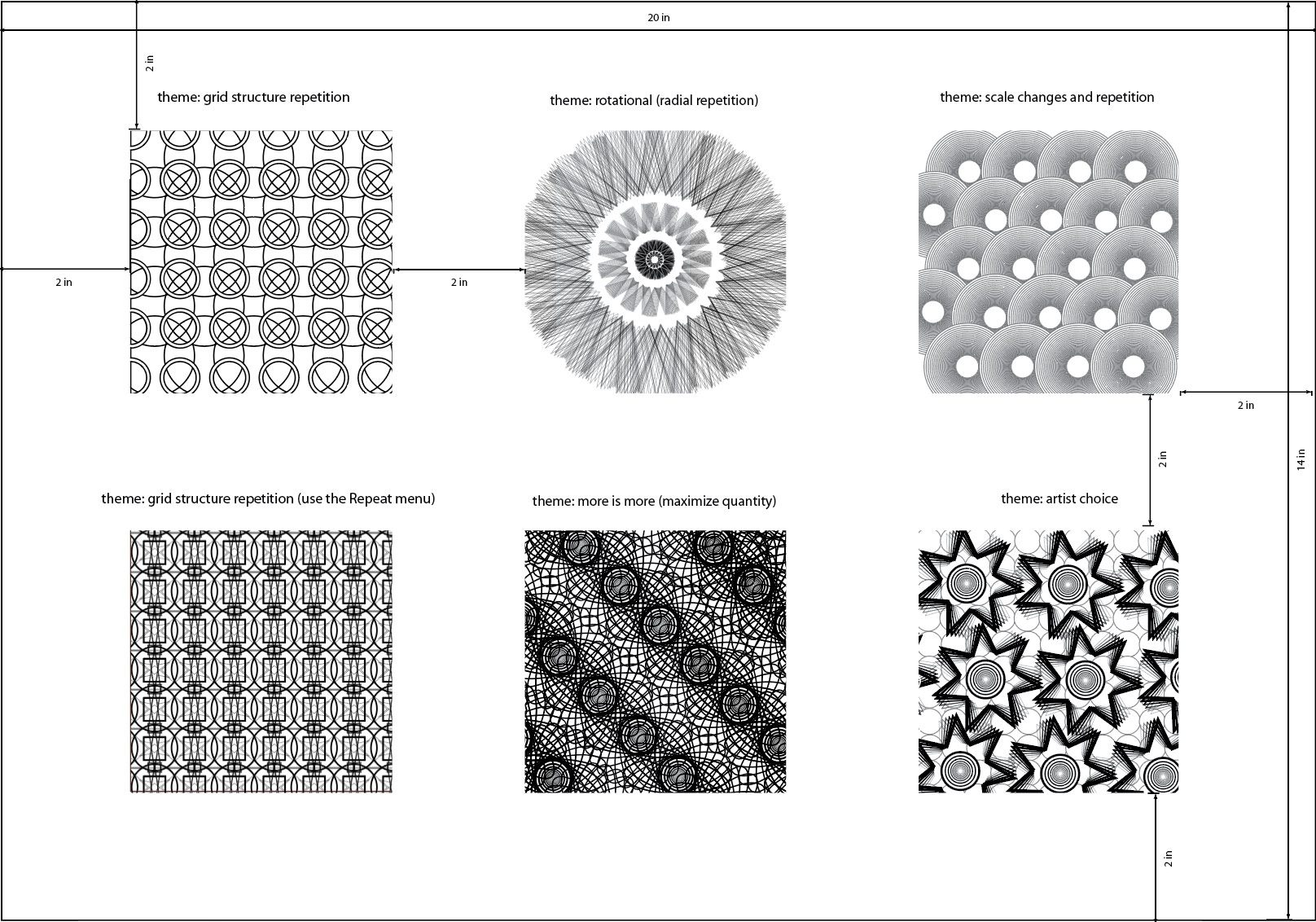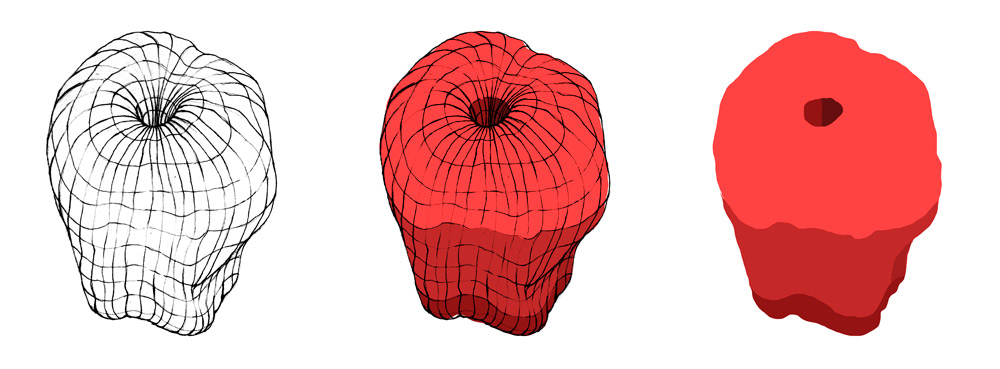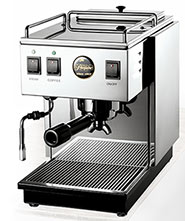Assignment 1: Pattern Studies
1. Set up a new document in Adobe Illustrator that is 20 inches wide by 14 inches tall.
2. Using RECTANGLES, ELIPSES, POLYGONS, AND STARS ONLY, create 6 pattern studies.
3. Your pattern studies should be 4 inches by 4 inches using only Black and White Stroke and Fills.
4. Keep an even 2 inch border around each pattern study.
5. Make 6 BLACK AND WHITE pattern studies based on the following concepts:
6. Before you start, make a simple "super unit" form to build into a pattern using repetition:
Units and Super-Unit forms
Wucious Wong defines a Super-Unit form as a complex form composed of a group of simple geometric figures. These figures are called “units”.

- #1 experiment with GRID STRUCTURES to create patterns (NO use of Illustrator's Repeat Cmd.)
Reference reading
- #2 experiment with ROTATION to create patterns (NO use of Illustrator's Repeat Cmd.)
- #3 experiment with SCALE CHANGES to create patterns (NO use of Illustrator's Repeat Cmd.T)
- #4 experiment with GRID STRUCTURES to create patterns (WITH use of Illustrator's Repeat Cmd.)
- #5 experiment with QUANTITY(WITH OR WITHOUT Illustrator's Repeat Cmd.)
- #6 experiment with EXPERIMENT WITH YOUR OWN PATTERN (No restrictions)
6. You can use White Rectangles to create borders around your patterns.
7. Save your file named firstname_lastname_shapes.ai
*see example below for some ideas
** all 6 pattern studies will be on the same document (20 x 14 inches)

Parameters:
No Effects, Transparency, Filters, Brushes, Variable Stroke Widths, Gradients, Color etc.
Keep shapes as primitive geometric shapes (ellipses, squares, stars, polygons)
No shapes other than primitive shapes
Objectives: Adobe Illustrator
A. Document Set Up, Guides, Grids, Workspace
1. Select tool
2. Primitive Shape tools
3. Rotate tool
4. Transform tool, Transform panel
5. Stroke and Fill
6. Stroke and Fill color
7. Constraints
8. Repeating
9. Align tool
Criteria For Grading and Evaluation:
Basic Includes |
art board size |
| |
4 inch square areas for pattern studies |
| |
2 inch borders |
| |
black and white stroke and fill colors |
| |
primitive shapes used for pattern studies |
Idea |
pattern investigations listed above (grids, rotations, scale, repeat command) |
| |
repetition of "super-units" using scale, rotation, position, translation (applied to grids, rotations, scale, line, quantity, and individual) |
Effort
(visual production)
|
Ambition with production - ambition with what you set out to do
Ambition with effort - how much you put into your idea and how much time you spent
Ambition to delivery - how much attention to detail and level of development and finish |
10 pts |
Total |
What to Turn in:
1. name your AI file:
firstname_lastname_shapes.ai
2. Submit your file to SIU Desire to Learn > HERE
-Log into your D2L Account (Click on the Drop Boxes Module and follow the instructions)
Assignment 3: Animal
From Adobe Stock, download a digital photograph (bitmap) of an animal, reptile, or insect, you are to remake the image with layered shapes in Illustrator as a vector illustration. Images must be real photographs from Adobe Stock, not AI generated or previous Illustrations.
Animal Selection:
- Choose an animal that has a strong, directional light source. Low light and diffuse light that doesn't provide shadows won't work well
- Choose an animal with short fur, no fur, or smooth skin.
- Choose an animal with some type of form to its body (butterflies and many birds won't work)
- Choose an animal that has light colored features (an all black animal will not work well)
- Choose an animal image that is framed well (the animal takes up the frame and we can see its whole body) and has some type of natural background (not on white or on transparent)
- Choose an animal image that has a sharp focus for the whole image.
- Choose an image with a high resolution (1200 px width or height at the very minimum). All photographs should be from Adobe Stock.
Getting Started
- Pay special attention to the image as shapes rather than textures and lines.
- When looking at the image, break it down from the largest shapes to smallest shapes. (don't start with the feathers, spots, hair, bumps, etc.)
- Think of creating your animal as if it's a stack of cut pieces of colored paper.
- Think of creating your animal like a topographic map (topology). The biggest pieces will be at the bottom of the stack.
- Use the topology of your animal by breaking your shapes down based on cross-contour lines.
(you won't be drawing the lines in your file, but visualize them as you look at your animal)

Guidelines:
- File size should be 7.5 inches by 10 inches.
- Original image must be placed and embedded into the Illustrator file for tracing.
- Color palette limited to 5 BASE COLORS. You can add tints (white) and shades (black) to each of these BASE COLORS.
- No Stroke Colors, Filters, Effects, Brushes, or Gradient, or Transparency are to be used.
- NO OPEN PATHS OR LINES
- Solid Color Only. ALL OF YOUR SHAPES WILL BE CLOSED PATHS (NO LINES)
- Save your file and name it firstname_lastname_animal.ai
- As an option, you may use a maximum of 3 shapes with a feathered edge.
Objectives: Adobe Illustrator
- Paths and Shapes (pen tool)
- Color Panel, Swatches Panel, Color Guide Panel
- Layers
- Composition
- Pen Tool
- Hand-Eye Coordination
Requirements:
- A minimum of 3 layers (all layers must be labeled)
- All paths must be closed.
- All colors in artwork must be saved in the Swatches Panel
- Simple background to describe the animal's environment.
- File named correctly and put into the Drop folder
- As mentioned in class, original source file must be embedded.
Criteria For Grading and Evaluation:
basic includes |
art board set up (10 inches by 7.5 inches)
use of at least 3 layers with labels.
color limited to 5 base colors plus tints (white) and shades (black)
all colors used are saved to the swatches panel
background illustration- indication of animal's environment
original image embedded in Illustrator file
|
design |
shapes - shape contours are observed from original image
form - illustration of animal is volumetric and 3D
light - use of light and shadow on animal's form
color - use of 5 colors plus tints and shades |
craft |
shapes - illustration is constructed of simple shapes from largest to smallest
shapes - pen tool usage - points, curves, control handles are refined and developed
shapes - pen tool used to make shapes with the fewest points.
color - colors are made from tints and shades (5 base colors)
|
effort |
image selection - animal appropriate for project goals, composition,
Ambition with process - effort in use of shapes to create illustration
Ambition to detail - shape construction is carefully observed and reacreated
Ambition to completion -
time devoted to completly recreate original including details |
| |
10 POINT DEDUCTION FOR USING:
BRUSHES (IE. OPEN PATHS)
VARIABLE STROKE WEIGHTS
EFFECTS OR FILTERS
GRADIENTS |
50 pts |
Total |
What to Turn in:
- name your AI file:
- firstname_lastname_animal.ai
- Submit your file to SIU Desire to Learn > HERE
Assignment 5 - Appliance
Starting with a black-and-white image of a house-hold appliance or hand-held power tool, you are to recreate the image in Illustrator using shapes, gradients, and tracing. Your Image will be "placed" in Illustrator as a template to trace. Final illustrations should be very representational of the original and use gradient fill colors to recreate the original light source, textures, surfaces, and form. Pay close attention to shadows, highlights, and perspective.

Objectives: Adobe Illustrator
- paths and shapes
- gradients - linear, radial, freeform,
- layers
- transparency
- pen/pencil tool, blob brush,
- perspective
- shadows and highlights
- other tools in illustrator - free transform, puppet warp, blend, warp, mesh, distort, etc.
Parameters:
-
No Brushes, Filters, or Effects.
- Edge Feather ONLY may be used on a maximum of 4 paths
- No colors...grayscale only
- No Image Trace, live paint
- Minimum of 5 layers (labeled)
- Placed file should be embedded in your document
Presentation:
- Art board should be 7.5 inches by 10 inches.
- Title - (typed at the bottome right of artboard in 8 pt type)
- Appliance Illustration
- AD 219 Spring 2025
- First Name Last Name
- Save files and name them firstname_lastname_appliance.ai
Criteria For Grading and Evaluation:
basics |
art board set up
placed image file embedded in document
5 layers used with labels
quality image selected based on assignment objectives
|
effort |
use of unique gradient colors for shapes
level of detail recreated from orignal source
time devoted inside and outside of class |
design |
use of gradients to simulate light source
use of gradients work to create textures
use of black and white gradients to build a full value range
shape construction creates volume and form
|
craft |
accuracty and specificity of shapes from source image
efficiency and smoothness of shapes
mixing of colors reflects specificity from original image
|
creativity |
image selection - composition, challenge factor (based on guidelines from instructor)
inventive and independent thinking used to solve problems
|
30 pts |
Total |
| |
|
critique |
presented in class |
| |
provide construcive feedback during class |
10 pts |
total |
What to Turn in:
- Name your AI file: firstname_lastname_appliance.ai
- Submit your file to SIU Desire to Learn > HERE
- Log into your D2L Account (Click on the Drop Boxes Module and follow the instructions)
Assignment 6 - Dada Photomontage
Collage Def:
The word Collage is derived from the French; "to glue" or to "stick together". Different types of collage have been explored by artists that include various materials.
A Photomontage uses photographs or parts of photographs.
Dadaists worked to expand notions of art by making art that was the opposite of art. They used collage, asemblage, and found objects to create new forms with new meanings.
Different approaches have been used to categorize collages. The Dadaists and others used a form of Photomontage that displays the TAMED CHAOS approach.
Step 1
- Search and collect images from the Metropolitan Museum's Open Access Library
- To save image in Google Chrome > Right + Click > Choose > Save Image As
- Collect at least 15 source images to include in the Photomontage. Save ALL IMAGES IN A SINGLE FOLER.
- Following guidelines in Step 2, create a Dada inspired photomontage in Photoshop
Step 2
- Create a NEW DOCUMENT in Photoshop that is 7.5 inches by 10 inches (resolution 300 pixels/inch)
- Using Photoshop and the tools for making selections, SELECT elements from their backgrounds to manipulate on different layers in Photoshop.
- COPY selections to your clipboard and PASTE into your new document.
- USE at least 15 different source images in your collage.
- REUSE one of your items at least 10 times.
- SAVE your file as firstname_lastname_collage.psd with ALL LAYERS SEPARATE
- Understanding file types - TIFF, JPG, PSD
- Photoshop Selection Tools - Marquee, Lasso, Color Range, Object selection, Quick Mask, Select and Mask
- Layers Panel
- Transform Objects (Move, Rotate, Scale)
- Resolution, File Size, Saving
Objectives: Collage Idea
- LAYER objects on many layers to create overlap
- Make clean, natural selections of each objects that are smooth and natural looking.
- Organize your elements into some sort of arrangment.
Parameters
- Prohibited items: ANYTHING THAT DOES NOT COME FROM THE MET OPEN ACCESS
(ie. Brushes, Gradients, Paint, Solid Shapes, Type, Text, Textures ,Lines, Paths.,etc. )
- No Filters or Effects or Adjustment layers - leave source images in their natural state
- Maintain the integrity of the objects so they aren't distorted. Allow the imagery to represent itself as you found it.
Criteria For Grading and Evaluation:
focus |
7.5 x 10 inch document - 300 ppi |
|
use of ALL Met Open Acces Images |
| |
use of at least 15 objects |
| |
use 1 element a minimum of 10 times |
| |
submitted - file sized, saved and submitted to D2L with correct name |
design |
clear strategy for organizing and arranging objects |
| |
use of color, shape, space, and other 2D elements of design to support composition |
craft |
demonstration of accurately selecting elements from source images. (simple, random selections will not be acceptable for all sources included in the collage) |
|
demonstration of accurately scaling, rotating, and moving elements from source images |
| |
demonstration of correct use of Photoshop tools, layers, file types |
creativity and ambition |
demonstration of a develped theme with consistent use of imagery to support a theme |
|
demonstraton of time and effort invested in exploring and developing a theme |
| |
demonstration of a variety of visual elements and a deliberateness to how they are used (how elements are selected from source images) |
| |
demonstration of attention to details |
| |
5 POINT DEDUCTION FOR USING ITEMS NOT FROM THE MET OPEN ACCESS WEBPAGE. |
15 pts |
Total |
When your photomontage is complete:
- In Photoshop, from the Image Menu, choose Image Size
- Make sure the box for Resample Image is checked.
- Choose Pixels for your Width and Height.
- For Pixel Dimensions, set the longest side to 2000 pixels
- Save your file with a new name so you don't overwrite your original.
- Submit your new PSD file to MyCourses.
What to Turn in:
- name your PSD file:
- firstname_lastname_photomontage.psd
- Submit your file to MyCourses > HERE
- -Log into your MyCourses Account (Click on the Drop Boxes Module and follow the instructions)


